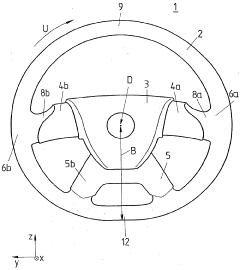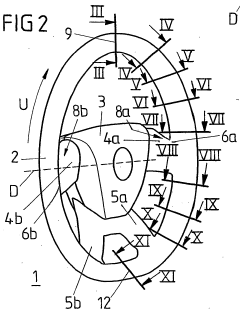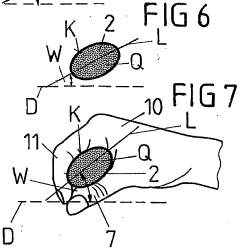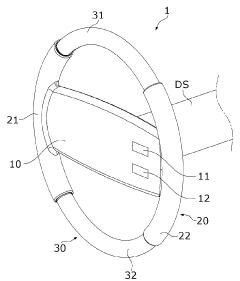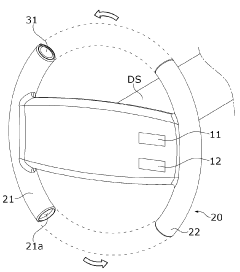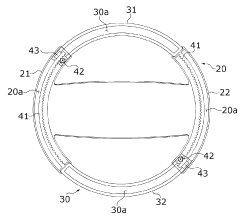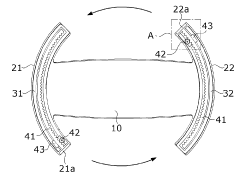Steering Wheel Evolution: From Manual to Automatic Control
JUL 18, 20259 MIN READ
Generate Your Research Report Instantly with AI Agent
Patsnap Eureka helps you evaluate technical feasibility & market potential.
Steering Tech Background
The evolution of steering wheel technology represents a significant journey in automotive engineering, spanning from the earliest manual systems to today's advanced automatic control mechanisms. This progression has been driven by the continuous pursuit of enhanced vehicle safety, improved driver comfort, and increased operational efficiency.
In the early days of automobiles, steering systems were entirely mechanical, relying on direct physical connections between the steering wheel and the vehicle's wheels. These manual systems required considerable physical effort from drivers, especially when maneuvering at low speeds or during parking maneuvers. The introduction of power steering in the 1950s marked a pivotal moment in steering technology, significantly reducing the physical exertion required to control a vehicle.
As automotive technology advanced, electronic power steering (EPS) systems emerged in the 1980s, offering more precise control and improved fuel efficiency compared to their hydraulic predecessors. EPS systems use electric motors to assist steering, allowing for variable assistance based on vehicle speed and driving conditions. This technology paved the way for more sophisticated steering control systems.
The late 20th and early 21st centuries saw the integration of advanced driver assistance systems (ADAS) into steering technology. Features such as lane keeping assist and adaptive cruise control began to augment the driver's control, representing the first steps towards semi-autonomous driving capabilities. These systems utilize sensors, cameras, and sophisticated algorithms to interpret the vehicle's environment and assist in steering decisions.
Recent years have witnessed the development of steer-by-wire technology, which eliminates the physical connection between the steering wheel and the wheels, replacing it with electronic controls and actuators. This innovation allows for greater flexibility in vehicle design and opens up new possibilities for steering control and feedback.
The current frontier of steering wheel evolution is the progression towards fully autonomous vehicles. In this paradigm, the traditional steering wheel may be replaced by alternative control interfaces or become entirely optional. Advanced AI systems, coupled with an array of sensors and connectivity features, are poised to take over the steering function, fundamentally changing the concept of vehicle control.
Throughout this technological evolution, the goals have remained consistent: to enhance safety, improve driver experience, and increase overall vehicle performance. The journey from manual to automatic control in steering technology reflects broader trends in automotive engineering, showcasing the industry's relentless pursuit of innovation and advancement.
In the early days of automobiles, steering systems were entirely mechanical, relying on direct physical connections between the steering wheel and the vehicle's wheels. These manual systems required considerable physical effort from drivers, especially when maneuvering at low speeds or during parking maneuvers. The introduction of power steering in the 1950s marked a pivotal moment in steering technology, significantly reducing the physical exertion required to control a vehicle.
As automotive technology advanced, electronic power steering (EPS) systems emerged in the 1980s, offering more precise control and improved fuel efficiency compared to their hydraulic predecessors. EPS systems use electric motors to assist steering, allowing for variable assistance based on vehicle speed and driving conditions. This technology paved the way for more sophisticated steering control systems.
The late 20th and early 21st centuries saw the integration of advanced driver assistance systems (ADAS) into steering technology. Features such as lane keeping assist and adaptive cruise control began to augment the driver's control, representing the first steps towards semi-autonomous driving capabilities. These systems utilize sensors, cameras, and sophisticated algorithms to interpret the vehicle's environment and assist in steering decisions.
Recent years have witnessed the development of steer-by-wire technology, which eliminates the physical connection between the steering wheel and the wheels, replacing it with electronic controls and actuators. This innovation allows for greater flexibility in vehicle design and opens up new possibilities for steering control and feedback.
The current frontier of steering wheel evolution is the progression towards fully autonomous vehicles. In this paradigm, the traditional steering wheel may be replaced by alternative control interfaces or become entirely optional. Advanced AI systems, coupled with an array of sensors and connectivity features, are poised to take over the steering function, fundamentally changing the concept of vehicle control.
Throughout this technological evolution, the goals have remained consistent: to enhance safety, improve driver experience, and increase overall vehicle performance. The journey from manual to automatic control in steering technology reflects broader trends in automotive engineering, showcasing the industry's relentless pursuit of innovation and advancement.
Market Demand Analysis
The market demand for steering wheel technology has undergone significant shifts in recent years, driven by advancements in autonomous driving and the increasing focus on vehicle safety and comfort. As vehicles transition from manual to automatic control, the steering wheel's role and functionality are evolving, creating new opportunities and challenges in the automotive industry.
Consumer preferences are increasingly leaning towards advanced driver assistance systems (ADAS) and semi-autonomous features. This trend is reflected in the growing market for vehicles equipped with lane-keeping assist, adaptive cruise control, and automated parking systems. These technologies represent intermediate steps in the evolution from manual to fully autonomous steering, and their adoption rates are steadily rising across various vehicle segments.
Safety considerations are a primary driver of market demand for advanced steering technologies. With human error being a major factor in road accidents, there is a strong push for systems that can enhance driver awareness and reaction times. This has led to increased interest in haptic feedback steering wheels and steer-by-wire systems, which can provide more immediate and precise responses to road conditions and potential hazards.
The luxury vehicle segment has been at the forefront of adopting innovative steering technologies. High-end automakers are introducing concepts such as retractable steering wheels and multi-function steering controls to differentiate their products and cater to tech-savvy consumers. This trend is gradually trickling down to mid-range vehicles, expanding the market for advanced steering systems.
Environmental concerns and the shift towards electric vehicles (EVs) are also influencing steering wheel technology demand. EVs often incorporate regenerative braking systems that can be controlled through the steering wheel, creating a need for more integrated and sophisticated steering interfaces.
The commercial vehicle sector presents another significant market opportunity. Fleet operators are showing increased interest in technologies that can improve driver comfort and reduce fatigue on long hauls. This has led to demand for ergonomic steering wheel designs and semi-autonomous driving capabilities in trucks and buses.
However, the market faces challenges in terms of consumer acceptance and regulatory hurdles. While there is enthusiasm for advanced technologies, there remains a segment of consumers who prefer traditional manual control. Additionally, regulations regarding autonomous driving and steering systems vary across regions, creating a complex landscape for manufacturers and suppliers.
Looking ahead, the market for steering wheel technologies is expected to continue growing as vehicles progress towards higher levels of autonomy. The integration of artificial intelligence and machine learning into steering systems is likely to open up new possibilities for predictive steering assistance and personalized driving experiences, further driving market demand in this evolving sector.
Consumer preferences are increasingly leaning towards advanced driver assistance systems (ADAS) and semi-autonomous features. This trend is reflected in the growing market for vehicles equipped with lane-keeping assist, adaptive cruise control, and automated parking systems. These technologies represent intermediate steps in the evolution from manual to fully autonomous steering, and their adoption rates are steadily rising across various vehicle segments.
Safety considerations are a primary driver of market demand for advanced steering technologies. With human error being a major factor in road accidents, there is a strong push for systems that can enhance driver awareness and reaction times. This has led to increased interest in haptic feedback steering wheels and steer-by-wire systems, which can provide more immediate and precise responses to road conditions and potential hazards.
The luxury vehicle segment has been at the forefront of adopting innovative steering technologies. High-end automakers are introducing concepts such as retractable steering wheels and multi-function steering controls to differentiate their products and cater to tech-savvy consumers. This trend is gradually trickling down to mid-range vehicles, expanding the market for advanced steering systems.
Environmental concerns and the shift towards electric vehicles (EVs) are also influencing steering wheel technology demand. EVs often incorporate regenerative braking systems that can be controlled through the steering wheel, creating a need for more integrated and sophisticated steering interfaces.
The commercial vehicle sector presents another significant market opportunity. Fleet operators are showing increased interest in technologies that can improve driver comfort and reduce fatigue on long hauls. This has led to demand for ergonomic steering wheel designs and semi-autonomous driving capabilities in trucks and buses.
However, the market faces challenges in terms of consumer acceptance and regulatory hurdles. While there is enthusiasm for advanced technologies, there remains a segment of consumers who prefer traditional manual control. Additionally, regulations regarding autonomous driving and steering systems vary across regions, creating a complex landscape for manufacturers and suppliers.
Looking ahead, the market for steering wheel technologies is expected to continue growing as vehicles progress towards higher levels of autonomy. The integration of artificial intelligence and machine learning into steering systems is likely to open up new possibilities for predictive steering assistance and personalized driving experiences, further driving market demand in this evolving sector.
Current Challenges
The evolution of steering wheel technology from manual to automatic control faces several significant challenges that need to be addressed for widespread adoption and optimal performance. One of the primary obstacles is ensuring the safety and reliability of autonomous steering systems. As vehicles transition from human-controlled to computer-controlled steering, there is a critical need to develop robust algorithms and fail-safe mechanisms that can handle a wide range of driving scenarios and potential system failures.
Another major challenge lies in the integration of steering control systems with other autonomous vehicle technologies. The steering system must seamlessly communicate and coordinate with various sensors, cameras, and other control units to provide a cohesive and responsive driving experience. This integration requires sophisticated software architecture and high-speed data processing capabilities to manage the complex interactions between different vehicle systems.
User acceptance and trust in autonomous steering technology present a significant hurdle. Many drivers are accustomed to having direct control over their vehicles and may be hesitant to relinquish control to an automated system. Overcoming this psychological barrier requires not only technological advancements but also effective communication and education to build public confidence in the safety and reliability of autonomous steering systems.
The regulatory landscape poses another challenge for the widespread implementation of autonomous steering technology. As this technology rapidly evolves, policymakers and regulatory bodies are struggling to keep pace with appropriate guidelines and standards. The lack of clear and consistent regulations across different regions can hinder the development and deployment of autonomous steering systems on a global scale.
Cost considerations also play a crucial role in the adoption of advanced steering technologies. The sophisticated sensors, actuators, and computing systems required for autonomous steering can significantly increase the overall cost of vehicles. Manufacturers face the challenge of balancing the implementation of cutting-edge technology with maintaining affordability for consumers.
Cybersecurity concerns have emerged as a critical issue in the development of autonomous steering systems. As vehicles become more connected and reliant on software, they become potential targets for cyber attacks. Ensuring the security of steering control systems against hacking attempts and unauthorized access is paramount to prevent potentially catastrophic consequences on the road.
Lastly, the transition period where both manually controlled and autonomous vehicles share the road presents unique challenges. Developing systems that can effectively interact with human drivers and anticipate their behaviors adds another layer of complexity to autonomous steering technology. This transition phase requires careful planning and implementation to ensure the safety of all road users during this technological shift.
Another major challenge lies in the integration of steering control systems with other autonomous vehicle technologies. The steering system must seamlessly communicate and coordinate with various sensors, cameras, and other control units to provide a cohesive and responsive driving experience. This integration requires sophisticated software architecture and high-speed data processing capabilities to manage the complex interactions between different vehicle systems.
User acceptance and trust in autonomous steering technology present a significant hurdle. Many drivers are accustomed to having direct control over their vehicles and may be hesitant to relinquish control to an automated system. Overcoming this psychological barrier requires not only technological advancements but also effective communication and education to build public confidence in the safety and reliability of autonomous steering systems.
The regulatory landscape poses another challenge for the widespread implementation of autonomous steering technology. As this technology rapidly evolves, policymakers and regulatory bodies are struggling to keep pace with appropriate guidelines and standards. The lack of clear and consistent regulations across different regions can hinder the development and deployment of autonomous steering systems on a global scale.
Cost considerations also play a crucial role in the adoption of advanced steering technologies. The sophisticated sensors, actuators, and computing systems required for autonomous steering can significantly increase the overall cost of vehicles. Manufacturers face the challenge of balancing the implementation of cutting-edge technology with maintaining affordability for consumers.
Cybersecurity concerns have emerged as a critical issue in the development of autonomous steering systems. As vehicles become more connected and reliant on software, they become potential targets for cyber attacks. Ensuring the security of steering control systems against hacking attempts and unauthorized access is paramount to prevent potentially catastrophic consequences on the road.
Lastly, the transition period where both manually controlled and autonomous vehicles share the road presents unique challenges. Developing systems that can effectively interact with human drivers and anticipate their behaviors adds another layer of complexity to autonomous steering technology. This transition phase requires careful planning and implementation to ensure the safety of all road users during this technological shift.
Existing Solutions
01 Electronic steering control systems
Advanced electronic systems for steering control, incorporating sensors, actuators, and control units to enhance vehicle handling and safety. These systems can include features like adaptive steering, lane-keeping assistance, and automated parking.- Electronic steering control systems: Advanced electronic systems for steering wheel control, incorporating sensors and actuators to enhance vehicle handling and safety. These systems can include features like adaptive steering, lane-keeping assistance, and automated parking.
- Steering wheel ergonomics and adjustability: Designs focusing on improving steering wheel comfort and adaptability for different drivers. This includes adjustable steering columns, telescoping mechanisms, and ergonomic grip designs to reduce driver fatigue and enhance control.
- Integration of controls on steering wheel: Incorporation of various vehicle controls directly on the steering wheel for easy access. This can include audio controls, cruise control buttons, and display interfaces, allowing drivers to manage multiple functions without taking their hands off the wheel.
- Steering systems for autonomous vehicles: Specialized steering control systems designed for autonomous and semi-autonomous vehicles. These systems integrate with AI and sensor technologies to enable precise steering control without human intervention.
- Steer-by-wire technology: Advanced steering systems that replace traditional mechanical linkages with electronic controls. This technology allows for more precise steering, reduced weight, and the potential for customizable steering feel and response.
02 Steering wheel-mounted controls
Integration of various vehicle controls directly onto the steering wheel, allowing drivers to operate multiple functions without removing their hands from the wheel. This can include audio controls, cruise control, phone operations, and vehicle information display controls.Expand Specific Solutions03 Steer-by-wire systems
Advanced steering systems that replace traditional mechanical linkages with electronic controls, sensors, and actuators. These systems can offer improved responsiveness, customizable steering feel, and enhanced safety features.Expand Specific Solutions04 Adaptive steering systems
Steering systems that can adjust their characteristics based on vehicle speed, driving conditions, or driver preferences. These systems can provide easier low-speed maneuvering and increased stability at higher speeds.Expand Specific Solutions05 Haptic feedback in steering controls
Implementation of tactile feedback mechanisms in steering wheels or controls to provide drivers with additional information or warnings. This can include vibrations or resistance changes to alert drivers of lane departures, potential collisions, or other safety-critical situations.Expand Specific Solutions
Key Industry Players
The steering wheel evolution from manual to automatic control represents a significant shift in automotive technology, currently in a transitional phase. The market is expanding rapidly, driven by increasing demand for advanced driver assistance systems and autonomous vehicles. While the technology is maturing, it's not yet fully mature. Key players like JTEKT Corp., BMW, Toyota, Ford, and Tesla are at the forefront, investing heavily in research and development. These companies are competing to develop more sophisticated and reliable steering systems, integrating features such as lane-keeping assistance and self-parking capabilities. The competitive landscape is intensifying as traditional automotive manufacturers face challenges from tech companies entering the space, pushing innovation and accelerating the transition towards fully autonomous steering systems.
Toyota Motor Corp.
Technical Solution: Toyota has developed an advanced steering wheel system that integrates manual and automatic control seamlessly. Their system utilizes a steer-by-wire technology, which replaces traditional mechanical linkages with electronic controls[1]. This allows for variable steering ratios and adaptive feedback based on driving conditions. Toyota's steering wheel incorporates haptic feedback and touch-sensitive controls, enabling drivers to switch between manual and autonomous modes effortlessly[3]. The system also features a retractable steering wheel for fully autonomous driving scenarios, maximizing interior space when not in use[5].
Strengths: Seamless transition between manual and autonomous modes, enhanced safety features, and space-saving design. Weaknesses: Potential complexity in system maintenance and higher initial cost compared to traditional steering systems.
Ford Global Technologies LLC
Technical Solution: Ford has pioneered a hybrid steering wheel system that adapts to various levels of autonomous driving. Their technology incorporates a shape-shifting steering wheel that can transform between a traditional circular shape for manual driving and a compact rectangular controller for semi-autonomous modes[2]. The system uses advanced sensors and AI algorithms to predict driver intent and adjust steering assistance accordingly. Ford's steering wheel also features an integrated display that provides real-time information on vehicle status and autonomous driving capabilities[4]. In fully autonomous mode, the steering wheel can retract into the dashboard, creating a more spacious and versatile interior[6].
Strengths: Innovative shape-shifting design, intuitive user interface, and adaptability to different driving modes. Weaknesses: Potential reliability concerns due to complex mechanical components and higher manufacturing costs.
Core Innovations
Steering wheel for a motor vehicle
PatentWO2006105745A2
Innovation
- A steering wheel design where the cross-sectional contour of the rim changes along its circumference, with varying orientations and shapes to accommodate the driver's hands, including adjustable sections that can be manually or automatically adjusted to optimize grip and comfort, featuring elongated contours and angled longitudinal axes to reduce wrist strain and enhance visibility and support.
Vehicle steering wheel
PatentPendingKR1020240035007A
Innovation
- A variable steering wheel design featuring a wheel base, fixed rims with storage spaces, and a driving mechanism using rack and pinion gears to adjust the shape between stored and extended modes, allowing drivers to select their preferred configuration.
Regulatory Framework
The regulatory framework surrounding steering wheel technology has evolved significantly alongside the progression from manual to automatic control systems. As vehicles become increasingly autonomous, regulatory bodies worldwide have had to adapt their policies to ensure safety, reliability, and legal compliance.
In the early stages of automotive development, regulations primarily focused on basic safety standards for manual steering systems. These included requirements for steering wheel size, grip, and responsiveness. As power steering became more prevalent, regulations expanded to cover hydraulic and electric power steering systems, ensuring their reliability and fail-safe mechanisms.
With the advent of drive-by-wire technology, which replaced mechanical linkages with electronic controls, regulators faced new challenges. They had to develop standards for electronic control units (ECUs), sensors, and actuators that now play crucial roles in steering systems. This led to the implementation of stringent electromagnetic compatibility (EMC) requirements and cybersecurity protocols to protect against potential hacking or interference.
The introduction of advanced driver assistance systems (ADAS) and semi-autonomous features prompted further regulatory updates. Agencies such as the National Highway Traffic Safety Administration (NHTSA) in the United States and the European New Car Assessment Programme (Euro NCAP) developed guidelines for lane-keeping assist, automated parking, and other steering-related functions. These regulations often require extensive testing and validation procedures to ensure system reliability and safety.
As fully autonomous vehicles become a reality, regulators are grappling with entirely new paradigms. The concept of a vehicle without a steering wheel challenges traditional definitions of driver control and responsibility. Some jurisdictions have begun to allow testing of such vehicles under controlled conditions, while others are still developing appropriate regulatory frameworks.
International efforts to harmonize regulations have become increasingly important as automotive technologies transcend national borders. The United Nations Economic Commission for Europe (UNECE) has been instrumental in developing global technical regulations for automated driving systems, including those related to steering control.
Looking ahead, regulators face the complex task of balancing innovation with safety concerns. They must create flexible frameworks that can accommodate rapid technological advancements while maintaining rigorous safety standards. This includes addressing liability issues in accidents involving autonomous steering systems and ensuring that human drivers can safely interact with increasingly automated vehicles.
In the early stages of automotive development, regulations primarily focused on basic safety standards for manual steering systems. These included requirements for steering wheel size, grip, and responsiveness. As power steering became more prevalent, regulations expanded to cover hydraulic and electric power steering systems, ensuring their reliability and fail-safe mechanisms.
With the advent of drive-by-wire technology, which replaced mechanical linkages with electronic controls, regulators faced new challenges. They had to develop standards for electronic control units (ECUs), sensors, and actuators that now play crucial roles in steering systems. This led to the implementation of stringent electromagnetic compatibility (EMC) requirements and cybersecurity protocols to protect against potential hacking or interference.
The introduction of advanced driver assistance systems (ADAS) and semi-autonomous features prompted further regulatory updates. Agencies such as the National Highway Traffic Safety Administration (NHTSA) in the United States and the European New Car Assessment Programme (Euro NCAP) developed guidelines for lane-keeping assist, automated parking, and other steering-related functions. These regulations often require extensive testing and validation procedures to ensure system reliability and safety.
As fully autonomous vehicles become a reality, regulators are grappling with entirely new paradigms. The concept of a vehicle without a steering wheel challenges traditional definitions of driver control and responsibility. Some jurisdictions have begun to allow testing of such vehicles under controlled conditions, while others are still developing appropriate regulatory frameworks.
International efforts to harmonize regulations have become increasingly important as automotive technologies transcend national borders. The United Nations Economic Commission for Europe (UNECE) has been instrumental in developing global technical regulations for automated driving systems, including those related to steering control.
Looking ahead, regulators face the complex task of balancing innovation with safety concerns. They must create flexible frameworks that can accommodate rapid technological advancements while maintaining rigorous safety standards. This includes addressing liability issues in accidents involving autonomous steering systems and ensuring that human drivers can safely interact with increasingly automated vehicles.
Human-Machine Interface
The evolution of steering wheel technology has significantly impacted the human-machine interface in vehicles. As automobiles transition from manual to automatic control, the steering wheel has become a focal point for integrating advanced driver assistance systems (ADAS) and autonomous driving capabilities. This transformation has necessitated a reimagining of how drivers interact with their vehicles.
Traditional steering wheels were purely mechanical devices, designed for direct control of the vehicle's direction. However, modern steering wheels have evolved into complex interfaces that incorporate multiple functions and feedback mechanisms. Touch-sensitive surfaces, haptic feedback, and integrated displays are now common features, allowing drivers to access various vehicle systems without removing their hands from the wheel.
The integration of drive-by-wire technology has further revolutionized the steering interface. This system replaces mechanical linkages with electronic controls, enabling more precise steering inputs and the potential for variable steering ratios. As a result, the physical effort required to steer has been greatly reduced, and the steering feel can be customized to suit different driving conditions or personal preferences.
With the advent of semi-autonomous driving systems, steering wheels have begun to incorporate visual and tactile cues to communicate the vehicle's status and intentions to the driver. LED light strips embedded in the wheel rim can indicate when autonomous mode is engaged or alert the driver to take control. Vibration patterns in the wheel can provide haptic warnings for lane departures or potential collisions.
As vehicles progress towards full autonomy, the role of the steering wheel is being reevaluated. Concept cars have showcased retractable steering wheels that can disappear into the dashboard when not needed, creating a more spacious and versatile cabin environment. Some designs propose replacing the traditional wheel with joysticks or yoke-style controls, which could offer greater flexibility in interior design and improved visibility.
The human-machine interface of steering systems must now balance the need for driver engagement with the increasing capabilities of autonomous technologies. Adaptive interfaces that can seamlessly transition between manual and automatic control are being developed, ensuring that drivers remain situationally aware and capable of taking over when necessary. This includes the use of augmented reality displays that project navigation and vehicle status information directly onto the windshield, complementing the steering wheel interface.
As steering technology continues to evolve, designers and engineers face the challenge of creating intuitive and safe interfaces that can accommodate varying levels of automation. The future steering wheel may become a multifunctional command center, capable of adapting to different driving modes and user preferences, while still maintaining the fundamental connection between driver and vehicle that has defined the automotive experience for over a century.
Traditional steering wheels were purely mechanical devices, designed for direct control of the vehicle's direction. However, modern steering wheels have evolved into complex interfaces that incorporate multiple functions and feedback mechanisms. Touch-sensitive surfaces, haptic feedback, and integrated displays are now common features, allowing drivers to access various vehicle systems without removing their hands from the wheel.
The integration of drive-by-wire technology has further revolutionized the steering interface. This system replaces mechanical linkages with electronic controls, enabling more precise steering inputs and the potential for variable steering ratios. As a result, the physical effort required to steer has been greatly reduced, and the steering feel can be customized to suit different driving conditions or personal preferences.
With the advent of semi-autonomous driving systems, steering wheels have begun to incorporate visual and tactile cues to communicate the vehicle's status and intentions to the driver. LED light strips embedded in the wheel rim can indicate when autonomous mode is engaged or alert the driver to take control. Vibration patterns in the wheel can provide haptic warnings for lane departures or potential collisions.
As vehicles progress towards full autonomy, the role of the steering wheel is being reevaluated. Concept cars have showcased retractable steering wheels that can disappear into the dashboard when not needed, creating a more spacious and versatile cabin environment. Some designs propose replacing the traditional wheel with joysticks or yoke-style controls, which could offer greater flexibility in interior design and improved visibility.
The human-machine interface of steering systems must now balance the need for driver engagement with the increasing capabilities of autonomous technologies. Adaptive interfaces that can seamlessly transition between manual and automatic control are being developed, ensuring that drivers remain situationally aware and capable of taking over when necessary. This includes the use of augmented reality displays that project navigation and vehicle status information directly onto the windshield, complementing the steering wheel interface.
As steering technology continues to evolve, designers and engineers face the challenge of creating intuitive and safe interfaces that can accommodate varying levels of automation. The future steering wheel may become a multifunctional command center, capable of adapting to different driving modes and user preferences, while still maintaining the fundamental connection between driver and vehicle that has defined the automotive experience for over a century.
Unlock deeper insights with Patsnap Eureka Quick Research — get a full tech report to explore trends and direct your research. Try now!
Generate Your Research Report Instantly with AI Agent
Supercharge your innovation with Patsnap Eureka AI Agent Platform!
